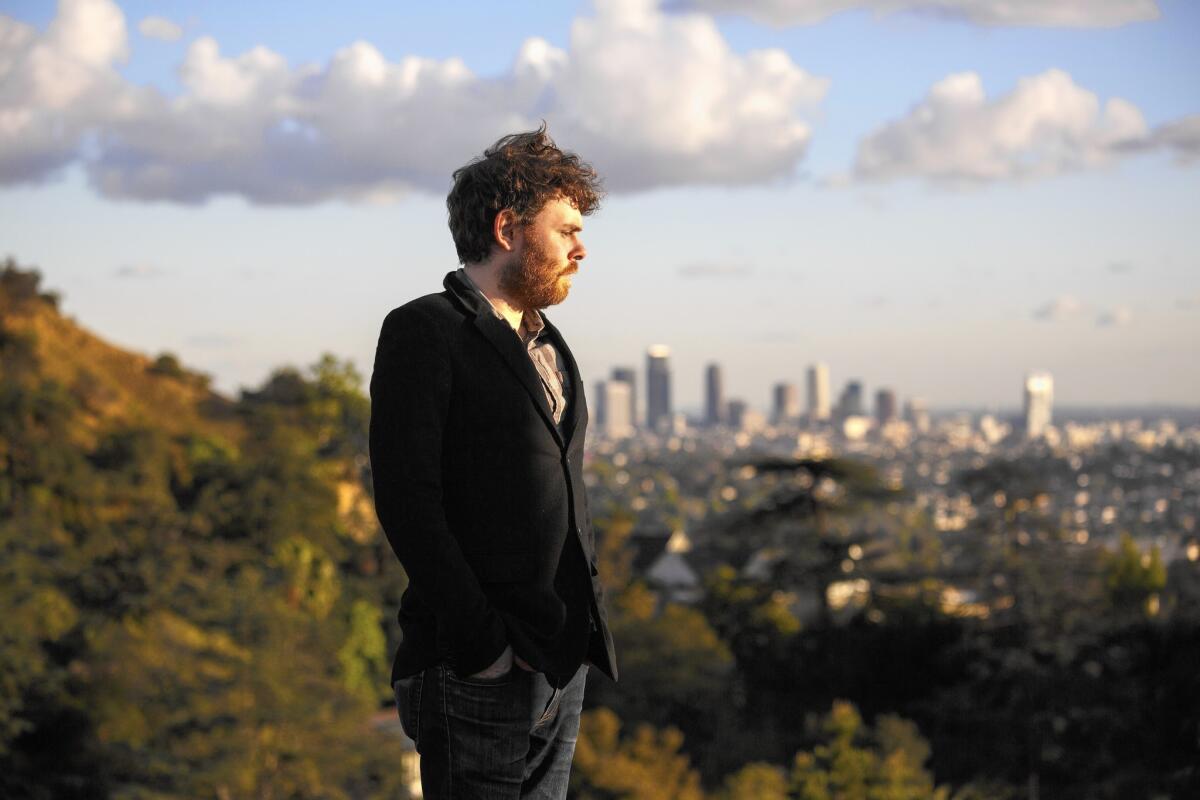Gabriel Kahane’s moving love letter to L.A., ‘The Ambassador’

Gabriel Kahane hearts L.A.
Although the Brooklyn-based singer-songwriter has been heralded as a star of New York’s new-music scene, his latest album is a love letter to the City of Angels. Now, “The Ambassador” — 13 songs, each based on a different Los Angeles address — has been developed into a theater performance piece directed by the Tony Award-winning John Tiffany. The touring show will make its West Coast premiere Friday at the Center for the Art of Performance at UCLA.
“I had this growing affection for the city, and I wanted to work through it artistically,” Kahane said. “For me, L.A. had been the relative I didn’t know very well and hadn’t made the effort — the second cousin I saw every five years at the family reunion.”
INTERACTIVE: Guide to L.A. landmarks in ‘The Ambassador’
Kahane, 33, was born in Venice but moved east when he was 2. His father is Jeffrey Kahane, a classical pianist and conductor who since 1997 has been music director of the Los Angeles Chamber Orchestra. A 2007-08 stint as a music director for the Center Theatre Group renewed the younger Kahane’s interest in this city, which he considers beautiful, temperamental and built mostly around the experience of private or hidden spaces.
Bringing “The Ambassador” to Los Angeles is emotionally resonant for Kahane. It’s as if the project, which also exists as a stand-alone album, were finally coming full circle.
“There are two L.A.s — the mythological L.A. of film, fiction and television, and then this very prone, vulnerable city. The city of storms and earthquakes and fires and Santa Ana winds,” he said. “And I have grown to perceive that architecture sits at the intersection of those things.”
Kahane happens to be good friends with the owners of the Hyman Levin House, built in the hills of Los Feliz and remodeled by Modernist great Rudolph Schindler in 1925. When Kahane visits L.A., he stays in the old servants’ quarters of the epic-looking home, with a dazzling view of downtown Los Angeles in front and the rugged hills and trails of Griffith Park in back.
On a gloomy afternoon, Kahane sat at a circular glass table in this house, staring at the brooding rain clouds sweeping across the sky as he tried to articulate why he hated talking about his music in terms of genre. He is, indeed, an adept classical musician, but he also writes pop songs, folk songs and rock songs. “The Ambassador” defies categorization as it soars from story to story and building to building on sonic wings made of strings, keyboards, bass, guitar and piano.
Kristy Edmunds, executive and artistic director of the Center for the Art of Performance at UCLA, said Kahane and other young musicians who experiment with multiple types of music were reclaiming aspects of contemporary classical music while maintaining a fluidity of vision.
“It’s an elasticity of forms, rather than sitting in the box of that form,” she said. “And to this, Gabriel adds such an astonishing sense of place, architecture, urban planning, design sensibility, public policy and the lack of public policy. Not too many musicians are writing about those things.”
Kahane likes how a friend, writer Joshua Wolf Shenk, describes him: “documentary songwriter.”
“It’s not exclusively what I do, but what I enjoyed about his application of that nomenclature for these songs is that it takes the question of genre off the table completely, and it’s just about content,” Kahane said, adding that otherwise, he becomes trapped in a meta world “where we talk about how people talk about what people like me do.”
Kahane reads voraciously for research, pleasure and context. A dedicated autodidact, he consumed books by Mike Davis, Joan Didion, Raymond Chandler, James M. Cain, urban and media historian and novelist Norman Klein and Midcentury architecture historian Esther McCoy to better understand the landscape, secret spaces and hidden history of the city. He also watched movies, including “Blade Runner,” “Los Angeles Plays Itself,” “Heat,” “Pulp Fiction” and “The Long Goodbye.”
Some of the addresses on “The Ambassador” came from this process, and others from his personal experiences with the city. Kahane chose places that captured his imagination, among them Union Station, the Bradbury Building, the now-demolished Ambassador Hotel and the Empire Liquor Mart, the South Los Angeles store where a 15-year-old African American girl named Latasha Harlins was shot and killed by Korean store owner Soon Ja Du in 1991.
The aftermath of the event often gets cited as one of the catalysts for the 1992 L.A. Riots, and Kahane calls his nine-minute song about it “the emotional center of the record.”
Another address belongs to the fairy tale home where Kahane stays. The song “Black Garden” explores the thoughts of a person viewing the sprawling metropolis below. Sings Kahane:
“In this black garden / I once called the selfish city, / I try to calculate the anguish / And the anger and all the aspirations / Of the millions who have lived here / And will live in desperation, /Who are careful and are careless / Whom I have cheated / Who thought the swindle that I offered / Was a salve.”
The stage show that accompanies the music also defies categorization, which is why director Tiffany (“Once,” “The Glass Menagerie”) feels that he, Kahane and their creative team have developed a new form of performance. It’s not a musical, a play or a rock show. Rather, it unfolds as Kahane and his fellow musicians play the songs on a stage decorated to look like a cityscape, built from analog ephemera, including huge stacks of books, scripts, VHS tapes and cassettes. Moments and scenes that Tiffany won’t reveal unfold within this context.
“I had to find a theatrical language with which to give the audience new access points to the songs,” Tiffany said of the 70-minute production, which was co-commissioned by the Brooklyn Academy of Music, CAP UCLA and the Laguna Beach Music Festival.
“I’m used to working with actors and texts, whereas here I had this beautiful music, and I had to create a visual language for it,” he said. “I found that really exciting.”
Tiffany, who refers to Kahane as “frighteningly talented,” left the songwriting to Kahane, although it was his idea to write an album around a series of L.A. addresses.
“Los Angeles is amazing at telling stories,” Tiffany said. “But it’s not great at telling its own story.”
The process of creating the stage show for “The Ambassador” exploded Kahane’s assumptions about theater and music, he said. The idea of singing on a set that was essentially a city made of books was particularly appealing, because the work pivots on the idea of “how we construct memory around place and how there’s this dance between memory and place.”
“The Ambassador” ultimately is a collection of impressions of a complex and misunderstood city.
“I tell stories through songs,” Kahane said. “The music may be unfamiliar at times, but there are traces of familiarity, and to me, those are the reward. Not that I want to think of it as vegetables and dessert. It’s more like pan-roasted Brussels sprouts with bacon and a ton of sea salt.”
More to Read
The biggest entertainment stories
Get our big stories about Hollywood, film, television, music, arts, culture and more right in your inbox as soon as they publish.
You may occasionally receive promotional content from the Los Angeles Times.











